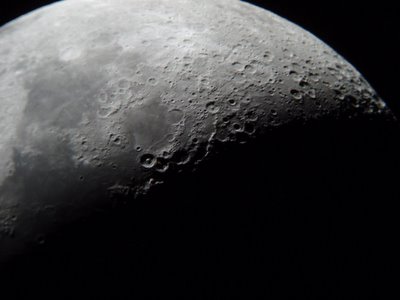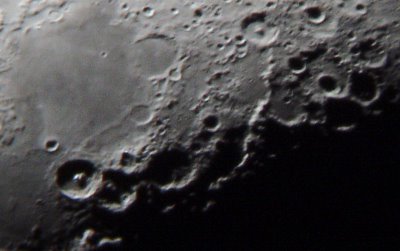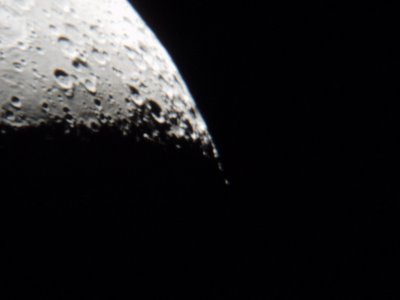Theophilus
 Got some fine shots of the moon at around 8 p.m. last night. The moon was 5 1/2 days old, and almost 37% illuminated. Below you can see a close-up near the middle of the terminator. The left-most prominent crater, with a very noticeable mountain in its center, is Theophilus.
Got some fine shots of the moon at around 8 p.m. last night. The moon was 5 1/2 days old, and almost 37% illuminated. Below you can see a close-up near the middle of the terminator. The left-most prominent crater, with a very noticeable mountain in its center, is Theophilus.
From Virtual Moon Atlas:
Type: Crater
Geological period: Eratosthenian (From -3.2 billions years to -1.1 billions years)
Dimension: 104x104Km / 61x61Mi
Height: 4400m / 13300ft
Height/Wide ratio: 0.044
Description:
Circular formation forming a remarkable trio with Cyrillus and Catharina. Tormented and steep slopes overhanging Sinus Asperitatis from 1200m and supporting Cyrillus to the South-East Theophilus F to the West and Mädler to the East. Very high walls with terraces overlapped by Theophilus B to the North-West. Flat floor. Imposing central mountain 1 400 m high with 4 summits. Line of crests hills and craterlets.
Interest: Exceptional formation
Observation period: 5 days after New Moon or 4 days after Full Moon
Minimal Instrument: 10x binoculars
Longitude: 26.4° East
Latitude: 11.4° South
Quadrant: South-East
Area: Theophilus crater North-West region
Name Origine:
Detailed Name: Theophilus
4 th century greek Philosopher born in Greece
Born at: Alexandrie? in ?
Dead at: ? in 412
Name Author: Riccioli (1651)
Name by Langrenus: Ferd. Francisci Imp. Rom. F.
Name by Hevelius: Mons Moschus
Name by Riccioli: Theophilus

Finally, you can see the horn of the crescent, below, near the South Pole. I thought it was cool how far it extended into space.

Comments